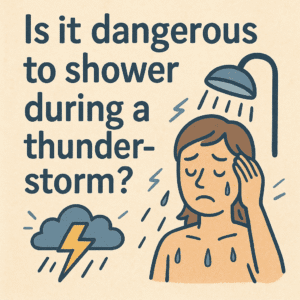Is It Dangerous to Shower During a Thunderstorm? A Science-Backed Answer
It’s a piece of advice many of us heard growing up, often dismissed as an old wives’ tale along the lines of not swimming after you eat. But unlike that myth, the warning to stay out of the shower during a thunderstorm is absolutely true and rooted in solid science. Let’s break down exactly why this common activity becomes a significant risk when lightning is in the area.
Yes, it is extremely dangerous to shower, bathe, or wash dishes during a thunderstorm. Lightning can travel through a building’s plumbing, and since water is an excellent conductor of electricity, this turns your faucet and shower head into a direct hazard.
How Lightning Travels Through Your Home’s Plumbing
The core of the danger lies in a simple fact: lightning is trying to find the fastest and easiest path to the ground. Unfortunately, the pipes and wires in your home provide a convenient superhighway for its massive electrical charge.
There are three main ways lightning can get to you indoors:
- Through Metal Plumbing: This is the most common path for shower-related incidents. If lightning strikes your house or even the ground nearby, it can energize the metal pipes (like copper) buried in the ground or running through your walls. That electrical charge travels instantaneously through the pipes to your faucets, shower head, and drain. If you are in the shower, the combination of water and metal creates a perfect path for the electricity to travel through you to get to the ground via the drain.
- Through Plastic (PEX) Pipes: Many people believe that modern plastic plumbing makes them safe. While PEX pipes themselves are not conductive, the water inside them is. Impurities and minerals in tap water allow it to conduct electricity. A lightning strike can still energize the water within the pipes, presenting a similar, though perhaps slightly reduced, risk.
- Through Electrical Wiring: Lightning can also travel through your home’s electrical system, phone lines, and cable lines. This is why you should avoid using corded electronics during a storm. While this is less likely to affect you in the shower directly, it’s part of the overall risk of being connected to any conductive system in the house.
What Do the Experts Say?
This isn’t just theory; it’s official guidance from leading safety organizations. Both the U.S. Centers for Disease Control and Prevention (CDC) and the National Weather Service (NWS) issue clear warnings about this.
Official Guidance from the CDC & NWS
The CDC explicitly states that it is a myth that you are safe from lightning indoors. They provide a clear list of activities to avoid, which are based on the principle of staying away from anything that conducts electricity.
- Avoid all contact with water during a thunderstorm. Do NOT bathe, shower, wash dishes, or wash your hands.
- Avoid using any electronic equipment connected to an electrical outlet.
- Avoid using corded phones. Cell phones and cordless phones are safe to use, as long as they are not being charged.
- Avoid contact with concrete floors or walls, as lightning can travel through the metal rebar within them.
The National Weather Service’s famous slogan, “When Thunder Roars, Go Indoors,” is only half the story. Once indoors, you must stay away from conductive paths to the outside.
Frequently Asked Thunderstorm Safety Questions
Is it safe to wash my hands or do the dishes?
No. For the same reason you shouldn’t shower, you should not wash your hands or do the dishes. Any contact with running water from a faucet connected to your home’s plumbing system is a risk.
Are some homes safer than others?
Yes, to a degree. Homes with proper lightning protection systems (lightning rods) and correctly grounded plumbing and electrical systems offer more protection by directing the charge to the ground. However, no system is 100% foolproof against a direct or extremely powerful nearby strike. It is always safest to assume the risk exists and take precautions.
How long should I wait after the storm passes?
Experts recommend following the 30-30 Rule. If you hear thunder, the storm is close enough to strike you. After the last clap of thunder you hear, wait a full 30 minutes before resuming any water-related or outdoor activities. Lightning can, and often does, strike several miles away from the main storm core.
Conclusion: It’s Not a Myth, It’s a Must
The warning to avoid showering during a thunderstorm is not an overcautious old wives’ tale; it is a critical piece of safety advice backed by science and promoted by experts worldwide. The conductive network of plumbing and wiring in our homes makes indoor activities involving water or electricity uniquely dangerous when lightning is present.
The next time the sky darkens and the thunder rumbles, remember that a shower can always wait. Your safety cannot. Stay dry, stay safe, and stay away from the plumbing.
For a visual explanation on the dangers of using water during a thunderstorm, you may find the following video informative:
Because of these events, you should definitely not do anything that involves water during a thunderstorm.




